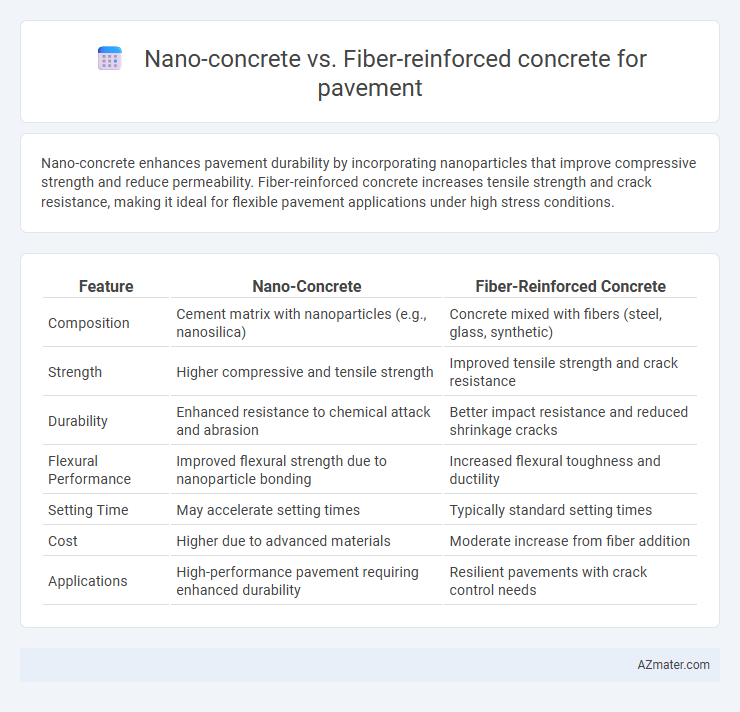Nano-concrete enhances pavement durability by incorporating nanoparticles that improve compressive strength and reduce permeability. Fiber-reinforced concrete increases tensile strength and crack resistance, making it ideal for flexible pavement applications under high stress conditions.
Table of Comparison
| Feature | Nano-Concrete | Fiber-Reinforced Concrete |
|---|---|---|
| Composition | Cement matrix with nanoparticles (e.g., nanosilica) | Concrete mixed with fibers (steel, glass, synthetic) |
| Strength | Higher compressive and tensile strength | Improved tensile strength and crack resistance |
| Durability | Enhanced resistance to chemical attack and abrasion | Better impact resistance and reduced shrinkage cracks |
| Flexural Performance | Improved flexural strength due to nanoparticle bonding | Increased flexural toughness and ductility |
| Setting Time | May accelerate setting times | Typically standard setting times |
| Cost | Higher due to advanced materials | Moderate increase from fiber addition |
| Applications | High-performance pavement requiring enhanced durability | Resilient pavements with crack control needs |
Introduction to Advanced Concrete Technologies
Nano-concrete incorporates nanoparticles to enhance the microstructure, resulting in improved strength, durability, and resistance to environmental degradation compared to conventional materials. Fiber-reinforced concrete utilizes synthetic or steel fibers to improve tensile strength, crack resistance, and impact toughness, making it suitable for heavy traffic pavements. Both advanced concrete technologies address critical pavement performance challenges by optimizing material properties to extend service life and reduce maintenance costs.
Defining Nano-concrete and Its Key Features
Nano-concrete incorporates nanoparticles such as silica or titanium dioxide to enhance the matrix at the nanoscale, improving mechanical properties and durability for pavement applications. Key features include increased compressive strength, reduced permeability, and enhanced resistance to cracking due to the refined pore structure. These advancements offer superior performance compared to conventional fiber-reinforced concrete, which relies on macro-scale fibers to improve tensile strength and ductility but lacks nanoscale material enhancements.
Understanding Fiber-Reinforced Concrete: Types and Benefits
Fiber-reinforced concrete (FRC) incorporates various fibers such as steel, glass, synthetic, or natural fibers to enhance pavement performance by improving tensile strength, crack resistance, and durability. Different types of FRC offer specific benefits; steel fibers provide high impact resistance, synthetic fibers improve flexural strength, and glass fibers resist alkali reactions, making FRC adaptable for diverse pavement applications. This engineered composite material reduces maintenance costs and extends pavement lifespan compared to conventional concrete and nano-concrete, which primarily focuses on microstructural improvements rather than mechanical reinforcement.
Comparative Analysis: Material Composition
Nano-concrete incorporates nanoparticles such as nano-silica or nano-titania which enhance the filler effect and improve the microstructure density, leading to superior strength and durability in pavement applications. Fiber-reinforced concrete (FRC) integrates discrete fibers such as steel, polypropylene, or glass to improve tensile strength, crack resistance, and ductility by bridging cracks during load stress. The material composition of nano-concrete optimizes particle packing and hydration reactions at the nanoscale, whereas fiber-reinforced concrete leverages mechanical reinforcement through fiber dispersion within the cement matrix, resulting in different performance profiles tailored for specific pavement loading conditions.
Mechanical Properties: Strength and Durability
Nano-concrete exhibits superior mechanical properties with enhanced compressive strength and improved microstructural density, leading to greater durability against wear and environmental degradation in pavement applications. Fiber-reinforced concrete increases tensile strength and crack resistance, providing improved flexural toughness and impact resilience essential for resisting dynamic loads on pavements. Combining nano additives with fiber reinforcement synergistically boosts both strength and durability, optimizing pavement performance under heavy traffic and harsh climatic conditions.
Performance Under Pavement Stress Conditions
Nano-concrete exhibits superior compressive strength and enhanced durability due to nanoparticles filling microvoids, resulting in improved resistance to abrasion and freeze-thaw cycles under pavement stress conditions. Fiber-reinforced concrete enhances tensile strength and crack resistance by distributing stress through embedded fibers, reducing fatigue damage from repeated traffic loads. Both materials improve pavement longevity, but nano-concrete excels in microstructural integrity while fiber-reinforced concrete offers better control of crack propagation.
Resistance to Cracking and Deformation
Nano-concrete exhibits superior resistance to cracking and deformation in pavement applications due to its enhanced microstructure and improved bonding at the nanoscale, which significantly reduces porosity and microcrack formation. Fiber-reinforced concrete, incorporating synthetic or steel fibers, increases tensile strength and controls crack propagation by distributing stress more evenly throughout the matrix, thereby improving deformation resistance under load. Studies indicate nano-concrete offers higher durability and longer lifespan for pavements in high-traffic areas, whereas fiber-reinforced concrete provides enhanced toughness and impact resistance, making both materials valuable depending on specific pavement performance requirements.
Constructability and Workability Differences
Nano-concrete offers superior workability due to its enhanced particle packing and reduced water demand, resulting in smoother placement and finishing for pavement applications. Fiber-reinforced concrete improves constructability by providing increased tensile strength and crack resistance, which reduces the need for jointing and repairs during pavement construction. The inclusion of fibers can, however, make mixing and pumping more challenging compared to the flowable consistency of nano-concrete.
Sustainability and Environmental Impact
Nano-concrete enhances pavement durability by incorporating nanoparticles that improve strength and reduce material usage, leading to lower carbon emissions during production. Fiber-reinforced concrete increases crack resistance and extends pavement lifespan, minimizing maintenance needs and resource consumption over time. Both technologies contribute to sustainable infrastructure by reducing environmental impact through improved performance and longevity.
Cost-effectiveness and Real-World Applications
Nano-concrete incorporates nanoparticles to enhance strength and durability while maintaining relatively low material costs, making it a cost-effective option for long-lasting pavements with reduced maintenance needs. Fiber-reinforced concrete adds synthetic or steel fibers to improve tensile strength and crack resistance, often increasing initial costs but offering significant savings in repair and lifespan extension in heavy-traffic areas. Real-world applications show nano-concrete's advantage in infrastructure requiring high durability and rapid setting times, while fiber-reinforced concrete excels in pavements subjected to dynamic loading and impact stresses.

Infographic: Nano-concrete vs Fiber-reinforced concrete for Pavement
 azmater.com
azmater.com